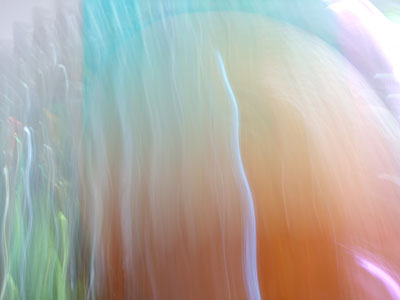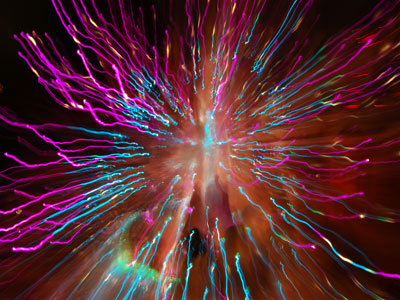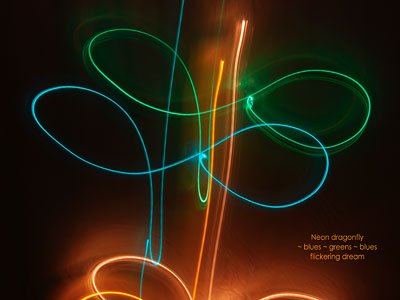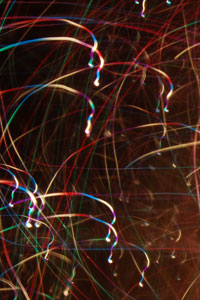The first abstract picture we took with our first digital camera (a Nikon D40x) was during the holiday season in 2007. It was actually a mistake -- a little camera movement while taking a picture of holiday lights, which made some tiny squiggles of light. But it looked cool, and after more than an hour of snapping pictures, we had a few good ones. Since then, we've taken thousands of pictures using camera movement with several cameras. We'll share here some background info, like exposure times, the types of movements and zoom we used, cameras, subjects and other details, as well as some thoughts about this kind of photography.

Happy Holiday Abstract © Dean Galloway
One of the first things we look for in camera movement pictures is an area of sharp focus. If everything is blurry, the picture almost always feels less satisfying. In Happy Holiday Abstract, above, there are some very sharp squiggles in the middle of the picture with some blurred shapes in the background that provide a nice feeling of depth. The subjects for this picture were various holiday lights in our living room, some of them a few inches away, and others across the room. It was taken with a Nikon D40x using a 3 second shutter speed (manual mode) at f8, ISO 100. The camera movement, shown by the blurred lights, was smooth, while a moving fiber optic display in the middle of the picture created a more squiggly look.

Fantasy Planet © Debra Galloway
While holiday lights got us started with camera movement photography, some of our favorite photos were of ordinary subjects in natural light, like Fantasy Planet, above. It was taken with a Fuji FinePix F50 – a compact camera with no manual mode, which makes it a little trickier to get a long enough shutter speed and good exposure. The program mode for this photo was Shutter Priority (1/2 second), the aperture was f8 (determined by setting the exposure bias to -2), and ISO 100. When you start seeing cool pictures like this on the LCD screen of your camera, it can be hard to stop snapping pictures. You never know what will come up next. You just need plenty of charged-up batteries and lots of space on your memory cards. You'll have to throw away most of what you get, but when you get a few good ones... it's quite addictive!

Fireworks Nebula © Dean Galloway
Zooming is another way to "paint" during the exposure. Fireworks Nebula, above, was handheld, twisting the zoom on the lens while pressing the shutter. It was a 2 second exposure at f16, ISO 100 (Nikon D40x). Another way to get this effect – especially if your camera won't zoom during the exposure – is to focus on the subject first (in this case, a fiber optic holiday display), lock the focus, then move away or toward the subject.

Neon Dragonfly © Debra Galloway
Neon Dragonfly, above, was "painted" to illustrate the haiku poem that's now on the picture. It came out perfectly on the first try, fitting the camera frame with no cropping. It was a 2 second exposure at f22, ISO 100 (Nikon D40x).
Before

|
|
After

|
And remember to experiment with your photo editing software afterwards. Above are before and after pictures of the top left corner of our picture, Energy. The edited version looks more energetic!
Thanks for reading Expressive Light – we hope you liked it, and if you have any comments or questions, please let us know on Facebook (the link to our page is below), or please send us an email.
|